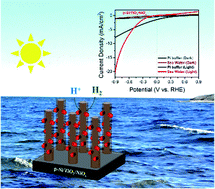当前位置:
X-MOL 学术
›
Sustain. Energy Fuels
›
论文详情
Our official English website, www.x-mol.net, welcomes your
feedback! (Note: you will need to create a separate account there.)
Photo-electrochemical hydrogen production from neutral phosphate buffer and seawater using micro-structured p-Si photo-electrodes functionalized by solution-based methods†
Sustainable Energy & Fuels ( IF 5.0 ) Pub Date : 2018-08-16 00:00:00 , DOI: 10.1039/c8se00291f Anurag Kawde 1, 2, 3, 4, 5 , Alagappan Annamalai 3, 6, 7 , Lucia Amidani 4, 5, 8 , Manuel Boniolo 3, 9, 10, 11 , Wai Ling Kwong 3, 9, 10, 11 , Anita Sellstedt 1, 3, 12, 13, 14 , Pieter Glatzel 4, 5, 8 , Thomas Wågberg 3, 6, 7 , Johannes Messinger 1, 2, 3, 9, 10
Sustainable Energy & Fuels ( IF 5.0 ) Pub Date : 2018-08-16 00:00:00 , DOI: 10.1039/c8se00291f Anurag Kawde 1, 2, 3, 4, 5 , Alagappan Annamalai 3, 6, 7 , Lucia Amidani 4, 5, 8 , Manuel Boniolo 3, 9, 10, 11 , Wai Ling Kwong 3, 9, 10, 11 , Anita Sellstedt 1, 3, 12, 13, 14 , Pieter Glatzel 4, 5, 8 , Thomas Wågberg 3, 6, 7 , Johannes Messinger 1, 2, 3, 9, 10
Affiliation

|
Solar fuels such as H2 generated from sunlight and seawater using earth-abundant materials are expected to be a crucial component of a next generation renewable energy mix. We herein report a systematic analysis of the photo-electrochemical performance of TiO2 coated, microstructured p-Si photo-electrodes (p-Si/TiO2) that were functionalized with CoOx and NiOx for H2 generation. These photocathodes were synthesized from commercial p-Si wafers employing wet chemical methods. In neutral phosphate buffer and standard 1 sun illumination, the p-Si/TiO2/NiOx photoelectrode showed a photocurrent density of −1.48 mA cm−2 at zero bias (0 VRHE), which was three times and 15 times better than the photocurrent densities of p-Si/TiO2/CoOx and p-Si/TiO2, respectively. No decline in activity was observed over a five hour test period, yielding a Faradaic efficiency of 96% for H2 production. Based on the electrochemical characterizations and the high energy resolution fluorescence detected X-ray absorption near edge structure (HERFD-XANES) and emission spectroscopy measurements performed at the Ti Kα1 fluorescence line, the superior performance of the p-Si/TiO2/NiOx photoelectrode was attributed to improved charge transfer properties induced by the NiOx coating on the protective TiO2 layer, in combination with a higher catalytic activity of NiOx for H2-evolution. Moreover, we report here an excellent photo-electrochemical performance of p-Si/TiO2/NiOx photoelectrode in corrosive artificial seawater (pH 8.4) with an unprecedented photocurrent density of 10 mA cm−2 at an applied potential of −0.7 VRHE, and of 20 mA cm−2 at −0.9 VRHE. The applied bias photon-to-current conversion efficiency (ABPE) at −0.7 VRHE and 10 mA cm−2 was found to be 5.1%.
中文翻译:

使用基于溶液的方法功能化的微结构p-Si光电极从中性磷酸盐缓冲液和海水中产生光电化学制氢†
预计使用大量地球物质从太阳光和海水中产生的H 2等太阳能燃料将成为下一代可再生能源组合的重要组成部分。我们在本文中报告了用CoO x和NiO x进行H 2生成功能化的TiO 2涂层,微结构化p-Si光电极(p-Si / TiO 2)的光电化学性能的系统分析。这些光阴极是使用湿化学方法从商业化的p-Si晶片合成的。在中性磷酸盐缓冲液和标准1阳光照射下,p-Si / TiO 2 / NiO x光电极显示的光电流密度为-1.48 mA cm -2在零偏压(0 V RHE)下,分别比p-Si / TiO 2 / CoO x和p-Si / TiO 2的光电流密度高三倍和15倍。在五个小时的测试期间未观察到活性降低,产生H 2的法拉第效率为96%。基于电化学表征和高能量分辨率荧光来检测邻近处的TiKα执行边缘结构(HERFD-XANES)和发射光谱的测量X射线吸收1条荧光线,对p-Si / TiO 2的性能优越2 /氧化镍x光电极归因于NiO诱导的电荷转移性能提高在保护性TiO 2层上涂覆x涂层,以及NiO x对H 2析出具有更高的催化活性。此外,我们在此报告p-Si / TiO 2 / NiO x光电极在腐蚀性人工海水(pH 8.4)中具有优异的光电化学性能,在-0.7 V RHE的施加电势下具有前所未有的10 mA cm -2的光电流密度,在-0.9 V RHE时为20 mA cm -2。发现在-0.7 V RHE和10 mA cm -2时施加的偏置光子-电流转换效率(ABPE)为5.1%。
更新日期:2018-08-16
中文翻译:

使用基于溶液的方法功能化的微结构p-Si光电极从中性磷酸盐缓冲液和海水中产生光电化学制氢†
预计使用大量地球物质从太阳光和海水中产生的H 2等太阳能燃料将成为下一代可再生能源组合的重要组成部分。我们在本文中报告了用CoO x和NiO x进行H 2生成功能化的TiO 2涂层,微结构化p-Si光电极(p-Si / TiO 2)的光电化学性能的系统分析。这些光阴极是使用湿化学方法从商业化的p-Si晶片合成的。在中性磷酸盐缓冲液和标准1阳光照射下,p-Si / TiO 2 / NiO x光电极显示的光电流密度为-1.48 mA cm -2在零偏压(0 V RHE)下,分别比p-Si / TiO 2 / CoO x和p-Si / TiO 2的光电流密度高三倍和15倍。在五个小时的测试期间未观察到活性降低,产生H 2的法拉第效率为96%。基于电化学表征和高能量分辨率荧光来检测邻近处的TiKα执行边缘结构(HERFD-XANES)和发射光谱的测量X射线吸收1条荧光线,对p-Si / TiO 2的性能优越2 /氧化镍x光电极归因于NiO诱导的电荷转移性能提高在保护性TiO 2层上涂覆x涂层,以及NiO x对H 2析出具有更高的催化活性。此外,我们在此报告p-Si / TiO 2 / NiO x光电极在腐蚀性人工海水(pH 8.4)中具有优异的光电化学性能,在-0.7 V RHE的施加电势下具有前所未有的10 mA cm -2的光电流密度,在-0.9 V RHE时为20 mA cm -2。发现在-0.7 V RHE和10 mA cm -2时施加的偏置光子-电流转换效率(ABPE)为5.1%。











































 京公网安备 11010802027423号
京公网安备 11010802027423号